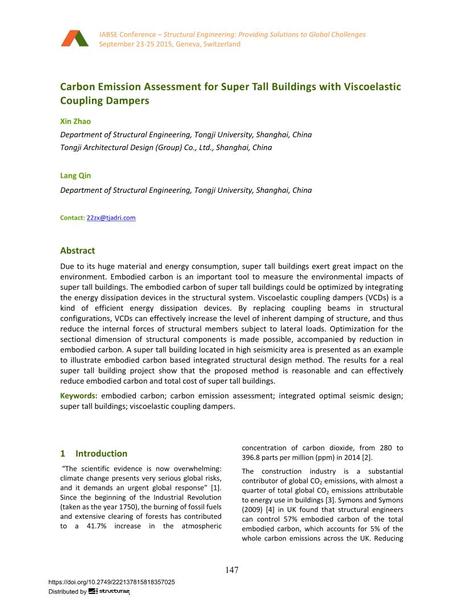Carbon Emission Assessment for Super Tall Buildings with Viscoelastic Coupling Dampers

|
|
|||||||||||
Détails bibliographiques
| Auteur(s): |
Xin Zhao
(Department of Structural Engineering, Tongji University, Shanghai, China Tongji Architectural Design (Group) Co., Ltd., Shanghai, China)
Lang Qin (Department of Structural Engineering, Tongji University, Shanghai, China) |
||||
|---|---|---|---|---|---|
| Médium: | papier de conférence | ||||
| Langue(s): | anglais | ||||
| Conférence: | IABSE Conference: Structural Engineering: Providing Solutions to Global Challenges, Geneva, Switzerland, September 2015 | ||||
| Publié dans: | IABSE Conference Geneva 2015 | ||||
|
|||||
| Page(s): | 147-154 | ||||
| Nombre total de pages (du PDF): | 8 | ||||
| Année: | 2015 | ||||
| DOI: | 10.2749/222137815818357025 | ||||
| Abstrait: |
Due to its huge material and energy consumption, super tall buildings exert great impact on the environment. Embodied carbon is an important tool to measure the environmental impacts of super tall buildings. The embodied carbon of super tall buildings could be optimized by integrating the energy dissipation devices in the structural system. Viscoelastic coupling dampers (VCDs) is a kind of efficient energy dissipation devices. By replacing coupling beams in structural configurations, VCDs can effectively increase the level of inherent damping of structure, and thus reduce the internal forces of structural members subject to lateral loads. Optimization for the sectional dimension of structural components is made possible, accompanied by reduction in embodied carbon. A super tall building located in high seismicity area is presented as an example to illustrate embodied carbon based integrated structural design method. The results for a real super tall building project show that the proposed method is reasonable and can effectively reduce embodied carbon and total cost of super tall buildings. |
||||
